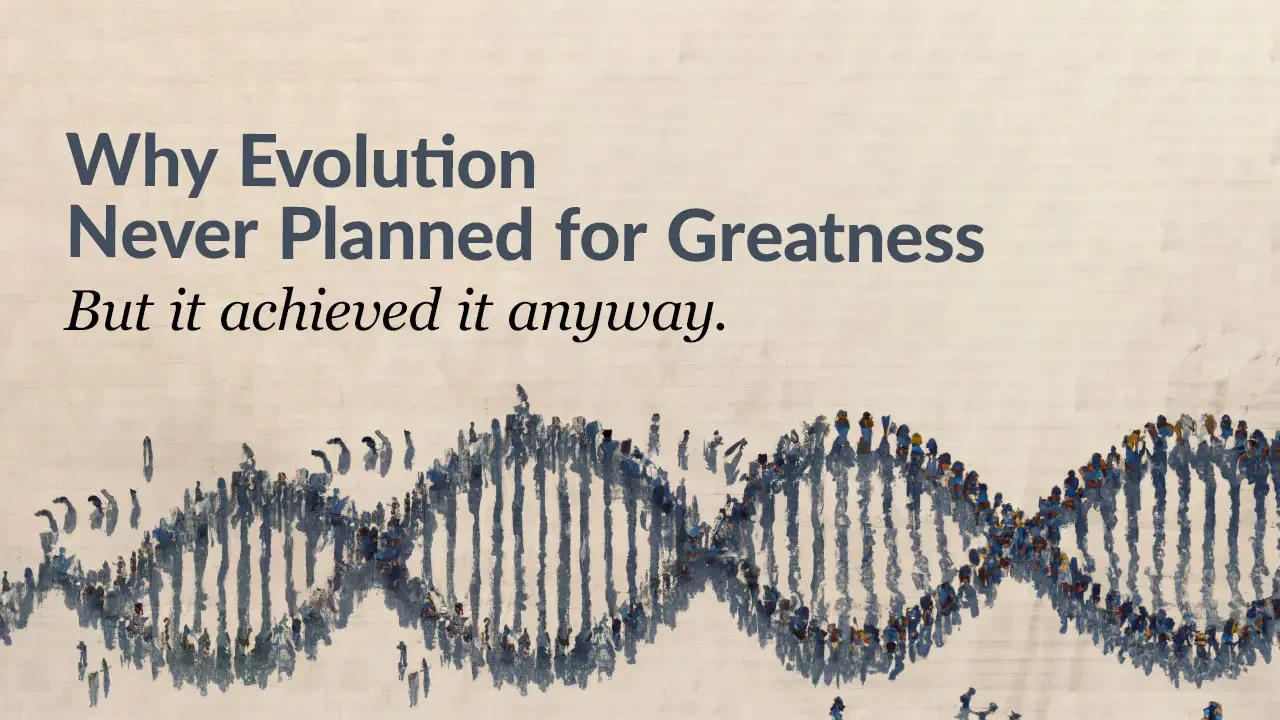Why Evolution Never Planned for Greatness. But it achieved it anyway.

What can you learn from evolution? That is, the process of evolving, not just the theory. This article is an open exploration into the genius of nature at a systems level and discusses evolution and how to think about objectives and end goals. Does evolution have a goal? And if so, what is the goal of evolution? We try to answer these questions below.
The first place to begin is to challenge the idea that having a set of objectives will bring you or your organisation greatness. Now this is a hard sell, and immediately, you may be thinking, how could one not have an objective? What about my KPIs, Big Hairy Audacious Goal, [insert another ridiculous abbreviation here] or OKR? Surely you must be wrong about this when everyone touts that you must have an objective? I understand this is a controversial matter, but it’s time to question the very essence of how we think about objectives to discover, build or innovate something great. It all starts with a quote:
‘‘The successful innovator asks where can we go from here rather than how can we get there’’*
- Adapted from Why greatness cannot be planned: the myth of the objective
What is particularly interesting is that the quote above seems like perfectly reasonable advice, of the type usually given by a professor or mentor. However, its main idea is largely overlooked by many who design formal approaches towards problem-solving, be it optimization in science and engineering or the shaping of public policy.
What is it about evolution that allows it to achieve its greatness?
Evolution is mind-blowingly unique. It’s a learning algorithm that discovers everything in nature in a single run. How do you get flight to work? How do you get photosynthesis to work? Human-level intelligence to work? You reading this very article, voila - we have evolution to thank… and it did that all in one single run, all with the exact same formula.
Evolution is a learning approach that discovers a solution to literally every problem it faces. With the same approach and algorithm. Nature, you’re CRAZY cool. Evolution cannot be so easily modelled or understood in a single formula, and the length and breadth of discussing this are beyond the scope of this article (and the writer). For those interested, underpinning this algorithm are the mechanisms of Evolution, namely:
- Mutation
- Non-random mating
- Gene flow
- Non-infinite population size (genetic drift)
- Natural selection
Interestingly, the very image of this article was generated by artificial intelligence (thanks Dall-e!). Something that most computer scientists figured out early on is that when creating AI, it’s best not to give the computer a defined objective.
How we think of objectives is wrong
We often think of objectives as something that we need to accomplish in order to be successful. But this way of thinking is actually counterproductive. Instead of thinking of objectives as something to be achieved, we should think of them as something to be evolved.
The process of evolution is not a goal-oriented one. It does not have an end destination in mind. Rather, it is a process of trial and error, of experimentation and adaptation. This is how new species arise and how existing species change over time.
The same principle applies to individuals. We are not born with a predetermined set of objectives that we must achieve in order to be successful. Instead, we should think of our lives, careers and organisations as a process of evolution. We should experiment with different things, try new things, and adapt to our surroundings. Only by constantly evolving can we hope to achieve greatness.
Case Study - UberEats
The founding builder and leader of Uber Eats, Jason Droege gives a good example of how he managed to create a startup within an already well-established business (Uber) - pulling off what all businesses dream of but the large majority are unable to achieve. Jason and his team were incredibly focused on achieving an objective: speed. To achieve speed, there was no selection - i.e.) you couldn't choose your favourite restaurant. How it worked initially is that UberEats delivered food that was already made and travelled well. Thus you received a great sandwich quickly, but initially, there was no choice. When Uber Eats asked their customers what they wanted, they framed every question around 'how fast should this service be', arrival times, etc. Only when UberEats dropped this objective and pivoted to offer restaurant selection, did they actually have a business. Dropping this objective led to an exponential increase in sales, so much so that they did as many sales in 4 hours as they had done over the last 3 days!
The lessons of evolution applied to a practical example: Our schooling systems

Image Reference: Flickr - Nationaal Archief
Let's discuss another practical example. Your country wishes to improve the schooling system to create smart and knowledgeable individuals… so a standardised test is run to hold everyone accountable. No matter what, there must be some accountability on the teachers, schools and politicians… so everyone must take this standardised test - a classic mandated outcome.
“When a measure becomes a target, it ceases to be a good measure.” - Goodhart's Law
Firstly, evolution does not aim for an A scorecard or a standardised, centralised approach. The idea of a standardised curriculum, with standardised tests in standardised classes, thrived in an era of industrialisation, human-powered production lines and the need for maximum efficiency. Our context has shifted radically. The surface-level problem is the countrywide standardised tests and curriculums, the root problem is that the approach isn’t evolutionary… not if you consider the approach hasn’t changed in 100+ years.
Now imagine an evolutionary learning system; a system that shares the ‘genes’ of what works… i.e.) a brilliant teacher in a small town in Florida with a class in the 90 percentile isn’t sharing what’s working (or why). Imagine moving from a top-down to a bottom-up system that embraces experimentation, iteration and customisation. This feels risky – how could we ever let a teacher experiment, what if it goes wrong? Rather, biomimicry asks, what could go right? How can we set up learning environments that can support iteration, experiment and failure in a safe and responsible manner?
Education is changing, with a bottom-up approach
The internet is akin to the industrial or agricultural revolution, but since we’re living through it, you and I take it for granted. One of the first use cases of the internet was learning online, and wow - how the world is now changing. Short online courses, microlearning, ed-tech and the sheer number of new additions entering the educational market means that the rate of iteration is increasing. Importantly, this is building from the bottom up. This is not to say there won’t be challenges along the way, innovation does take time… but the future looks bright when we remove a mandated outcome and agree to change.
“Your life does not get better by chance, it gets better by change.” – Jim Rohn
Summary
This article aims to help you (the reader) find a path not limited by ‘the shackles of a mandated outcome’. Evolution is a consistent question asked again and again, over millennia… how does one create conditions conducive to life.
Evolution is, well, evolutionary, not revolutionary. It makes incremental changes, not everything all at once. I believe that we should aim to mimic the mechanisms of evolution – looking for direction and not a destination.
A question to ponder: What are you evolving and what mandated outcome are you willing to let go of?
If you found this useful, could you do us a favour? Share this article with one other individual.
Until next time,
Think outside
Alistair Daynes
References:
Adapted from Kenneth O. Stanley and Joel Lehman: Why greatness cannot be planned: the myth of the objective

